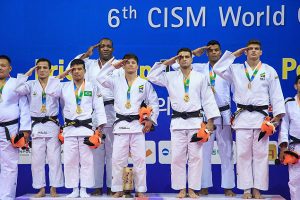 Rio de Janeiro is militarized for the Olympic Games, with more than 80,000 soldiers and police officers patrolling the streets. But in the games themselves, a much less visible process is taking place: a significant portion of participating athletes come from the military.
Rio de Janeiro is militarized for the Olympic Games, with more than 80,000 soldiers and police officers patrolling the streets. But in the games themselves, a much less visible process is taking place: a significant portion of participating athletes come from the military.
When the Brazilian judoka Rafaela Silva won the first gold medal in the 2016 Rio Olympics, the media emphasized her humble beginnings in the Ciudad de Dios favela, recalled that she had been excluded from the 2012 London games because of her race and highlighted the sacrifices that were necessary for Silva, as a black woman, to become an elite athlete in a sport dominated by white men. However, the accounts of Rafaela’s athletic career omitted an important detail: she is a sergeant in the Brazilian Navy.
If she had not entered the high performance athletes program (PAAR) of the Brazilian armed forces, it is very unlikely that Silva would have been able to climb the Olympic ladder and become a Pan American and global champion. As a military athlete, she enjoyed all of the benefits of a soldier: a salary, a health plan, payed vacation and access to the military’s athletic installations, where she was trained by specialists.
The case of the judoka is not the only one. In total, 145 of the 465 athletes that make up the Brazilian Olympic team, more than 30%, are also part of the armed forces. Soldiers, sergeants and colonels in the Navy, the Army and the Air Force are participating in 27 Olympic events, including everything from shooting, taekwondo and judo to beach volleyball, cycling and synchronized swimming. The entire judo team and half of the swim team are in the military. The number of members of the armed forces in the Brazilian Olympic Team has almost tripled since the 2012 London Olympics, when there were 51 military olympians, or 20% of the team.
The PAAR was created in 2008 with the support of the ministers of defense and sports. It quickly proved a successful program, and at the 2011 Military World Games, Brazil emerged as the winner, with 114 medals, followed by China, Italy, Poland and France. In the London Olympics in 2012, military athletes won five of Brazil’s 17 medals. In the 2016 games, military athletes hope to lead Brazil to victory.
The PAAR, which is less than 11 years old, already has 670 athletes, of which 76 are career officers and 594 are only temporarily in the military, including the sergeant-judoka Rafaela Silva.
“Being able to dedicate myself fully to my sport, receiving a salary and having the support of the Brazilian Air Force made a huge difference in my preparation,” said Bernardo Oliveira, who won a bronze medal in archery at the Pan American Games in Toronto in 2015. A military athlete’s salary can reach 3,200 reales ($1,000) per month.
Social Programs for Athletes
“Since 2005, the Brazilian government has had the best program in the world for individual sponsorship of athletes,” reads the webpage of the Brazilian Sports Ministry, presenting the Bolsa Atleta program. The program was started to support 300 Olympic and Paralympic athletes with a card that gave them between 300 and 2,500 reales per month, to incentivize potential world champions to dedicate as much time as possible to training.
Throughout the years, other non-exclusive programs to support athletes were created. In ten years, Bolsa Atleta has given out 43,000 benefit payments to more than 6,000 athletes, with a total value of 600 million reales. However, for Jorge Steinhilber, president of the Federal Physical Education Council and the Brazilian Olympic Academy, the program did not achieve its goals.
In an interview with El País, Steinhilber argued that throwing money at sports has its limits. He brought up the example of the gymnast Arthur Zanetti, who won a gold medal in London in 2012, but trains in a shed in São Caetano with no infrastructure. Steinhilber also criticized the way that Bolsa Atleta was conceived.
“The focus of the program has been to win more medals for Brazil to improve our Olympic ranking,” he said. “And that means prioritizing individual sports. But Brazil has more of a tradition in team sports.”
The problem, according to Steinhilber, is that the top of the sports pyramid cannot be improved without changing its base.
“In 40 percent of schools, there are no open spaces for children to play sports so that talented athletes can be discovered,” he said.
 There is a lack of physical education teachers, and most time dedicated to sports in schools ends up being used for recreation and games.
There is a lack of physical education teachers, and most time dedicated to sports in schools ends up being used for recreation and games.
Around 77% of the Brazilian athletes that are competing in the 2016 Olympics (358 out of 465) are receiving Bolsa Atleta. But only 31 percent practice team sports. In 2011, the government launched Bolsa Atleta Podio, which supports athletes who are in good positions to win medals in 2016 with contributions from state-owned companies. The 123 qualifying athletes, who rank among the top 20 in their respective sports, receive between 5,000 and 15,000 reales (between $1,600 and $5,000) per month.
In 2012, the Plan Brasil Medallas 2016 was launched, which sought to “place Brazil among the ten top countries in the Olympic Games and among the top five in the Pan American Games and the 2016 Rio Paralympics,” according to the Sports Ministry’s website. The program allocates a billion reales to prepare the next generation of Brazilian athletes, to build and equip high-performance training centers, to hire specialists and multi-disciplinary teams, to buy equipment and to finance travel for training and competition.
It’s not a coincidence that during the 2014 election campaign, Rafaela Silva, who was receiving the Bolsa Atleta Podio, came out in support of Dilma Rousseff.
“She pushed for support for our athletes,” Silva told BBC on Aug. 9, 2016. “The Bolsa Atleta program makes a huge difference and allows us to follow our dreams.”
The Military Games
In spite of its best efforts, Brazil is still very far away from its goal of landing among the top ten countries in the Rio Olympics, in contrast to the significant developments in sports achieved by other so-called emerging countries, such as Russia, China, the South Korea and Japan, with Cuba as the Latin American exception. In the United States, the main sports superpower since the fall of the Soviet Union, the universities, with funding from businesses, are responsible for preparing athletes. However, the U.S. model has not been followed by most European countries.
Either way, it appears that state support is necessary to emerge from a disadvantaged position. Since the 1950s, the United States and the Soviet Union always held the top two places in the medal count, with rare exceptions. The other top-ten spots went to Western European countries, especially East and West Germany, and little by little, to Eastern European and Asian countries. The Olympic Games were a live portrait of the Cold War.
China only began participating in the Olympics in the 1984 Los Angeles games, and won more and more medals each Olympics until coming in first place in Beijing in 2008. Although it wasn’t the only factor, China’s remarkable performance would not have been possible without the participation of the People’s Liberation Army in Chinese sports. The armed forces also play significant roles in preparing athletes in Russia, North and South Korea, Ukraine and Poland, as well as in certain European countries like Italy and Germany.
The short history of the Military World Games further clarifies the situation. After World War II, the International Military Sports Council (CISM) was founded, with headquarters in Brussels. The Warsaw Pact countries created another military sports council which would be dissolved at the end of the Cold War, concentrating all countries in the CISM, which soon gained recognition by the International Olympic Committee.
In 1995, the first Military World Games were held in Rome. For the first few installments, Russia or China usually won the most medals, closely followed by Italy, Croatia, South Korea, Ukraine and Germany. At the Military World Games in Rio in 2011, the first in which Brazil participated since founding the high performance athletes program (PAAR), Brazil won first place in the medal count, and at the subsequent Military World Games in South Korea in 2015, came in second place.
Around 9,000 athletes from over 100 countries participate in the Military World Games (compared to a little over 10,000 in the Olympics), competing in the same events as the Olympics as well as events more associated with the military, such as the naval pentathlon, the aeronautical pentathlon and parachuting. The main difference with the Olympics is the limited participation by the U.S., the UK, Australia and Western European countries. The U.S. averaged 12th place in the five Military World Games that have been held.
Brazil began to play a more significant role in the Military World Games since their military started to recruit athletes.
“Since starting to employ top athletes, Brazil became a force in the Military World Games,” reads an article in Folha de São Paolo from Feb. 22, 2016. “At the Rio games in 2011, Brazil won by two metrics: the most gold medals and the most total medals. In the 2015 games, in the South Korean city of Mungyeong, Brazil won the second-most gold medals. One year before starting the program, the Brazilian delegation had not won a single gold medal in the Hyderabad, India games of 2007.”
Other Latin American countries perform just as poorly in the Military World Games as they do in the Olympics, with the exception of Chile, which won 14th place in 2011. In general, Latin American countries perform considerably better than African and Arab countries.
The True Legacy of the Olympics
According to polls by Instituto Datafolha, taken in June 2016, 63% of Brazilians think that the Rio Olympics will cause more harm than good to the country, and half of Brazilians think that the games should be cancelled because they will expose Rio’s transportation and security problems (El País, July 19 2016). In contrast, a few years earlier, in June 2013, 64% of Brazilians supported the games, while only one out of four opposed them.
It was, certainly, a different Brazil. One of the main sports venues in Rio is the Guanabara Bay, where rowing, sailing and other competitions take place. Much of Rio’s waste water ends up in Guanabara Bay, which leaves the bay with high pollution levels. The government failed to complete its promise of reducing pollution in the bay by 80%, and the lakes around the Olympic Park also still have high levels of pollution.
The famous “legacy” that the games were supposed to bring Rio is invisible to the inhabitants of the city. The popular frustration with the games is not unusual; many other cities who have hosted Olympics have had similar levels of disappointment. According to an article in El País from July 19, “popular support for megaevents is in freefall.” For example, the city of Hamburg “decided to withdraw its candidacy for the 2024 Olympic Games after a referendum revealed that 51.6% of residents opposed the event.” Boston also withdrew an Olympic bid after finding out that its residents opposed it.
Everything suggests that the principal legacy of the games will be the double militarization. On one hand, the massive presence of the police and military. On the other, the participation of members of the military as athletes in the games. The first four medals won by Brazil were won by members of the military, three in judo and one in shooting. But the most symbolic medal, Rafaela Silva’s gold, will be remembered long after the final results.
The most serious legacy, however, is the militarization of the country and the city. Interim President Michel Temer made a decree on Aug. 8 widening the responsibilities and powers of the armed forces in Rio during the Olympics and Paralympics. The military will not only monitor airports, roadways and sports installations, but also entire neighborhoods such as Copacabana. In the city of Manaos, they will monitor the Hotel Tropical, which is housing visiting soccer teams.
But militarization affects much more than just areas associated with sports. During the games, 1,200 soldiers were deployed to Natal, the capital of Rio Grande do Norte, to fight drug trafficking, while others were sent to guarantee water distribution in Acre. Elsewhere, soldiers were deployed to oversee vaccinations and health care. Military authorities are worried by the constant deployment of the military because “servicepeople are not satisfied with the functions that have been assigned to them” (Estado de Sao Paulo, 7 de agosto de 2016).
One general complained to Estado de São Paolo, “the army should be a last resort, and a last resort shouldn’t be used all the time.”
 Although Brazil had plenty of time to plan security for the games, there are certain structural problems that cannot be covered up by a massive military presence. One soldier died in La Maré, a complex of 16 favelas next to the road that runs from the airport to the Olympic Village, when the military entered the complex on Wednesday, Aug. 10, as the games were beginning.
Although Brazil had plenty of time to plan security for the games, there are certain structural problems that cannot be covered up by a massive military presence. One soldier died in La Maré, a complex of 16 favelas next to the road that runs from the airport to the Olympic Village, when the military entered the complex on Wednesday, Aug. 10, as the games were beginning.
We are experiencing a growing presence of the military, both around megaevents and within elite sports themselves. The excuse for the former is security. The excuse for the latter is that the military is the only path available for many athletes. Without support from the state, or from private capital, there would be no elite sports and no broken records.
The fact that the media “forgets” to mention that the most celebrated athletes are no longer soccer players who learn on the streets, but people who need to ask for help from the military (or multinational corporations) to succeed. The militarization of sports is a sign of the times, in a world debating the commodification of nature and the militarization of life.



